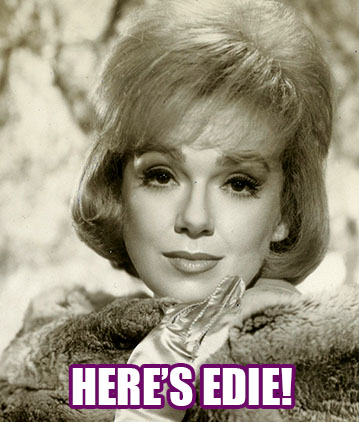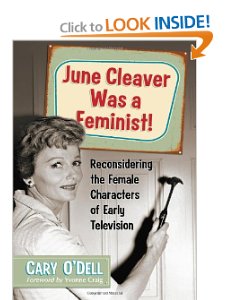




 |
 |
 |
 |
 |
|||
|
by Cary O'Dell
Over the years, many more than just RuPaul have been inspired by Miss Edie Adams. Today, when Adams' name is invoked it is usually as the partner and muse of her frequent TV co-star, and real-life husband, Ernie Kovacs. (The couple were married from 1954 until Kovacs' death in 1962.) Such is what happens when you marry one of the TV's medium's greatest and most influential geniuses.... But Edie Adams - as RuPaul, and others, will tell you - was more than just a Mrs. During an epically long career, Adams was featured on stage, on record, in films and, of course, on TV. She was born in Pennsylvania, in Kingston, to be exact. Later, her family would move to Tenafly, NJ. From childhood, Edie (nee Edith Elizabeth Enke) had two great talents - dress making and singing. Savvy from the beginning, she knew if she were to attempt a career in showbiz, she better have fallback, so she always kept her design and seamstress abilities sharp. Luckily, however, Edie's voice was quite remarkable, of an operatic quality, and so, after graduating high school, she auditioned for and was accepted into Julliard. Eventually, she earned a vocal degree form the prestigious school. Later still she graduated from the Columbia School of Drama and would later also study for at time at the Actors Studio. And, in the nascent days of her career, though she toyed for a time with "serious music," the Broadway stage and even once entertained a film contract, there was something about Edie that just made her so right for the then fledging TV medium. By 1950 she was appearing regularly on the small screen on the TV program "Versatile Varieties." Or, more to the point, she appeared in ads within the show whose sponsor was Bonnie Maid Linoleum. Alongside some other soon-to-be famous names - including Anne Francis and Eva Marie Saint - Adams was decked out in plaid and danced across the forever scuff-free floor during "VV's" program breaks. Also in 1950, Adams competed, on air, for a short-lived but interesting title. The "Miss U.S. Television" title and crown was the creation of the now defunct television network DuMont. It was a glamourous way to bring some attention - or, at least, male attention - to this new medium. The title got her attention all over the small screen, including appearances on various programs including "Talent Scouts" and Milton Berle. Her singing abilities on both then grabbed the attention of another TV producer who was looking for a "girl singer" for a program he was doing in Philadelphia with a young comic with a mighty moustache named Ernie Kovacs. It's not easy to describe the talent that was Ernie Kovacs. The phrase "TV comic" doesn't fully cut it. Milton Berle and others were "TV comics" but they were mainly performing skits and doing bits they had honed on the stagnant nightclub or theater stage. Kovacs, in contrast, saw all that the TV medium could to in the name of humor - sight gags, plays on time and perspective, the useful use of silence - and, in the process, helped both define and expand what this small screen medium could be. That was in 1951. And the show, over Philly's WPTV, was titled "Three to Get Ready." Though she considered herself a classical singer, Adams adapted her talent to pop songs for the show. She also adapted herself to Kovacs' wild, made-for-TV style. Soon she was part of his on-air troupe, proving herself an adept comedienne. Not long after, when Kovacs got his shot at a national, primetime series, over NBC (a summer replacement for "Kukla, Fran & Ollie") Adams was part of the ensemble that appeared with him. To say that the Kovacs and Adams formed a powerful show biz duo and new comedy team is an understatement. Soon, they were not only together on the air, they were together off of it too. Then, in 1954, following a courtship and engagement that seemed as madcap as one of Kovacs' on-air skits, Ernie and Edie eloped to Mexico City. During their time together, Edie would be both partner and powerful foil for many/most of Kovacs' on-air incarnations.
But she kept busy without him too. She bowed on Broadway in 1953 co-starring with Rosiland Russell in "Wonderful Town." A couple of years later, in 1956, she was on the boards again playing the role of Daisey Mae in "Lil'l Abner." She would go on to win the Tony Award for that role. When not supporting Ernie on any of his myriad of programs, she was appearing as herself on some of the variety shows and specials of the era - "The Bell Telephone Hour," "The Gary Moore Show," "Ed Sullivan Show," "Omnibus," "The Joey Bishop Show," "The Danny Kaye Show," and innumerable others. There was also her participation on the panels of such long-running games shows as "I've Got a Secret" and "What's My Line?" Then there were her aforementioned, sexy, iconic Muriel cigar commercials that ran in the 1960s and which made such an impact on RuPaul and others. Up on the big screen, Adams was also seen and shone in such films as the Oscar-winning "The Apartment" (1960); "Lover Come Back" (1961) with Rock Hudson and Doris Day; the Natalie Wood-Steve McQueen drama "Love with the Proper Stranger" (1963) and in the zany, madcap comedy "It's a Mad, Mad, Mad, Mad World" (1963) as well as - are you ready? - in Cheech and Chong's "Up in Smoke" in 1978.
And on TV....where wasn't she? She and Ernie co-starred with Lucy and Desi in their very last "I Love Lucy" episode. Then, between big screen assignments, Adams appeared on "GE Theatre," "The US Steel Hour" and she played the Fairy Godmother to Julie Andrews' "Cinderella" on TV's treatment of the classic tale in 1957. But tragedy struck in January of 1962. On the way home from a party, Kovacs lost control of his car and died in a single-vehicle accident. Though Kovacs left behind three children (two from Ernie's first marriage and a daughter, Mia, with Edie) and an extraordinary catalog of television innovation, he also left behind a mountain of debt and unpaid taxes. Along with facing that challenge, Edie also had to face a series of custody hearings brought by Ernie's first wife. Though the two older girls had always lived with Ernie and Edie, after his death, the first Mrs. Kovacs attempted to assert her parental rights. The two girls - Kip and Elizabeth - however wanted to stay with Edie. As the custody case wove its way through the LA courts - and as Kovacs' mother also filed suit against Adams for what she believed her late son's estate was worth - Edie did what she always did--she went back to work, to pay her attorneys and keep her family together. From 1963-1964, over ABC, Adams helmed her own half-hour musical-variety show, "Here's Edie" (a.k.a. "The Edie Adams Show"). It aired every other week, alternating with a program hosted by Sid Caeser. On "Here's Edie," Adams was able to display the full diversity of her talents. Along with singing some pretty songs, Adams got to do a variety of her hilarious, spot-on impersonations of everyone from Marilyn Monroe to Mae West to Jeanette MacDonald. Though her program was only on for a year, it welcomed an extraordinary group of guest performers including Sammy Davis, Jr., Count Basie, Nancy Wilson, Johnny Mathis, and Duke Ellington. On the program, Edie was also able to show off her sewing and design skills; she made many of the gowns she wore on the program. Sadly, despite a positive critical response to the program, "Here's Edie" wasn't renewed for a second season. Thankfully, now, the full run of the program is available on DVD. After that, it was onto nightclubs and additional film and TV appearances. Over the years, But the lady was not just a songbird and sexy, she was savvy. She lent her name and likeness to a chain of beauty salons franchised around the country which allowed her and her family - which would later include a son, Josh, that she had with her second husband - to remain solvent. Then, in 1990, Adams published her memoir, "Sing a Pretty Song," a thorough account of her life and, to a great extent, Kovacs', too. An important byproduct of the book was the confirmation of dates, productions and timelines that Adams reported. Kovacs had an eccentric and complicated career, with various series--evening, daytime, network, local - and Adams' accurate recall of all these has been a TV researcher's dream. Either as part of her work on her book or through the showbiz grapevine, slowly, Adams became aware of the great at-risk nature of so many of her and Kovacs' early programs. In fact, already, hundreds of hours of early television had already been erased, taped over or simply tossed out. Thanks almost entirely to Adams' efforts - and those of her son, Josh Mills - a plethora, a golden cross-section, of Kovacs' extraordinarily innovative comedy can now be seen - and enjoyed. Just as importantly, much of the work of Adams (who passed away in 2008 at the age of 81) can also be revisited as well so that she can now, too, be recognized as the individual, enormous talent that she was. |
|
Looking
for classic TV on DVD?/See below: |
||
